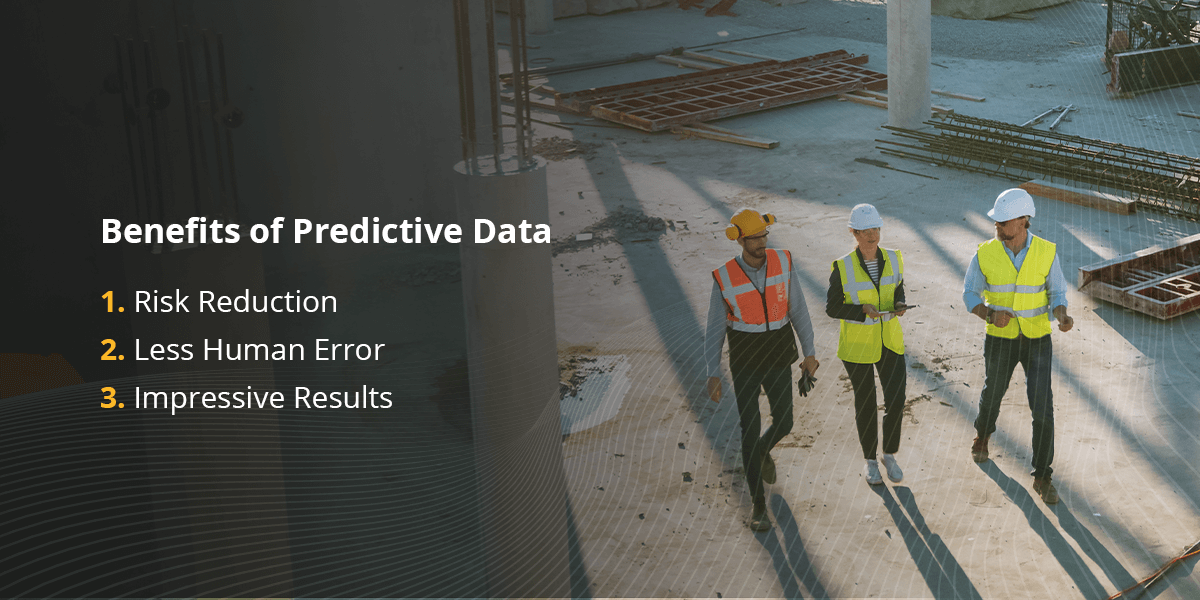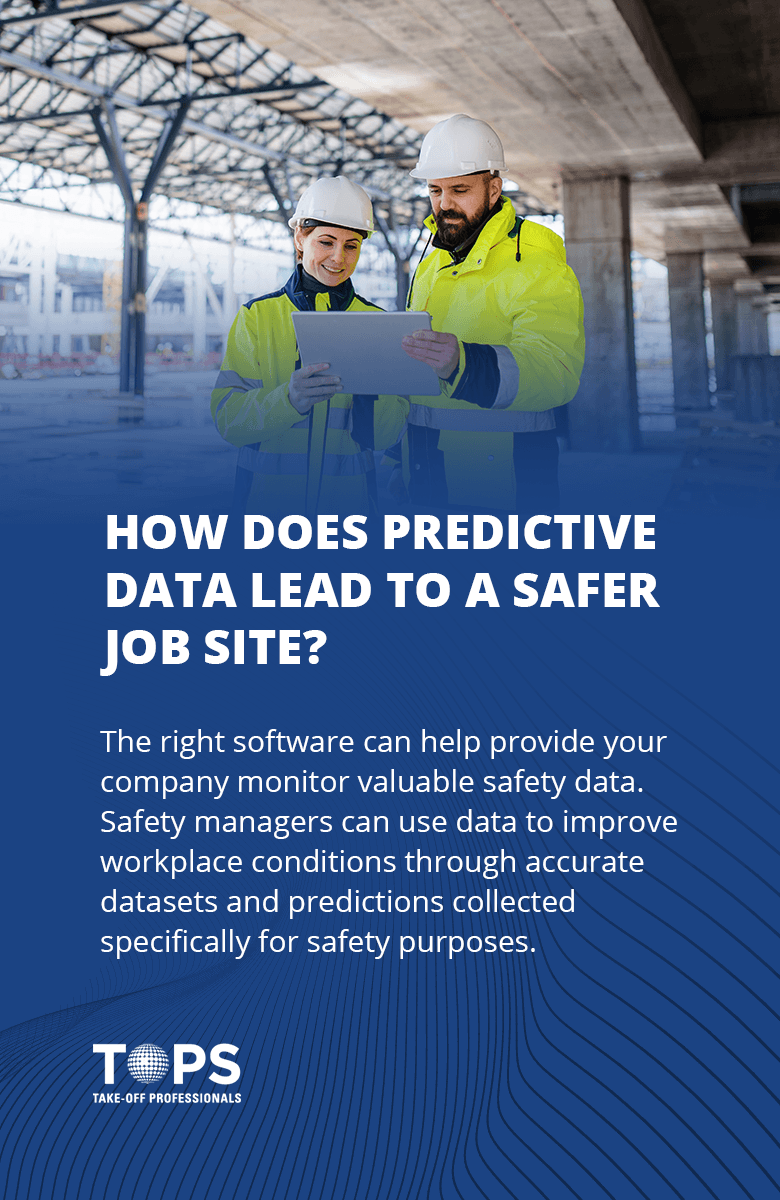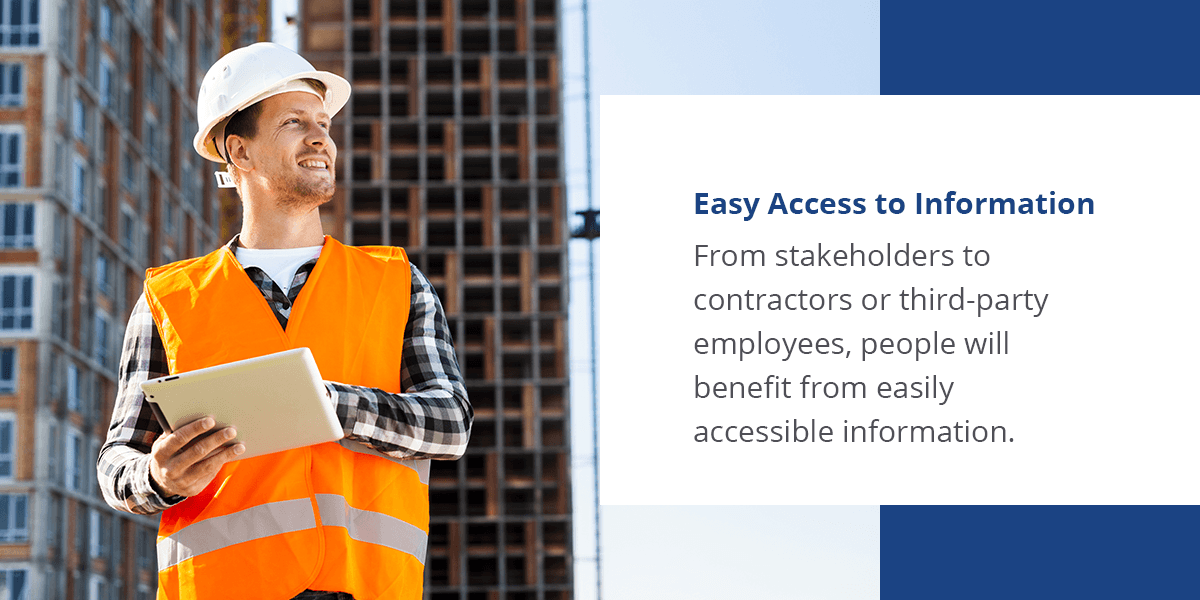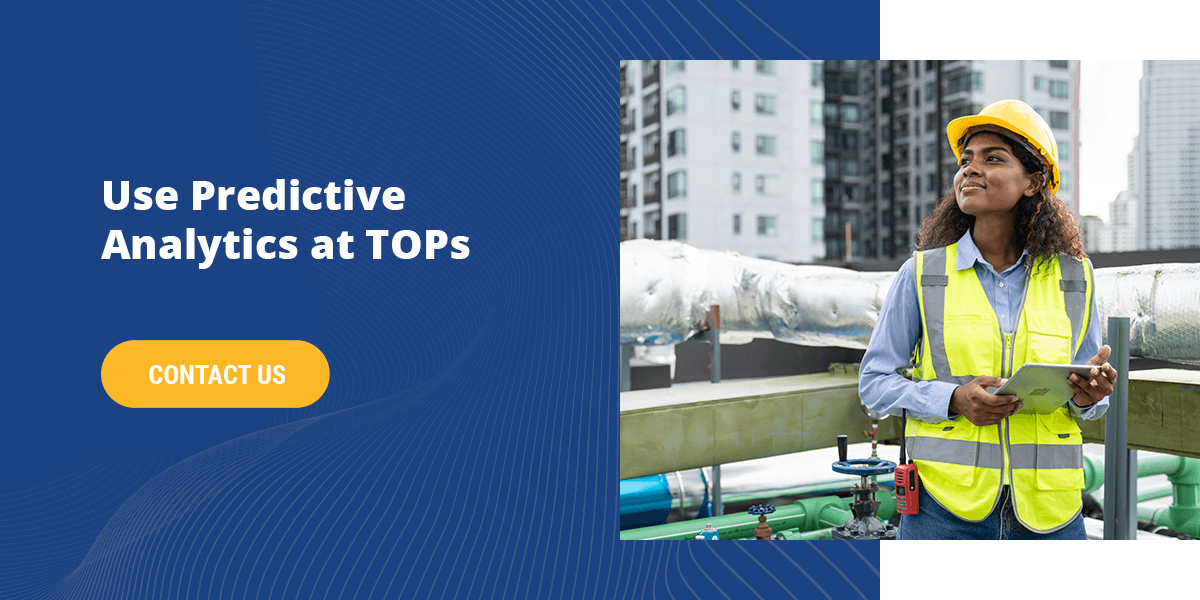Predictive data analysis helps companies use data and information to make good decisions, increase productivity and improve safety measures in the workplace. With predictable outcomes for your future projects, you can estimate how much you might need to spend on tasks or identify areas with a higher likelihood of causing injury.
Predictive data brings structure to structureless data. Data common to the construction industry may be hard to analyze or structure into understandable maps and tables. Predictive data analysis helps construction companies monitor important data to make their workplace safer and more efficient.
Benefits of Predictive Data
Using predictive data in the construction workplace has many benefits. Besides the typical benefits of risk reduction and increased safety measures, predictive data analytics reduce the chance of human error and lead to impressive results that will help a company thrive.

1. Risk Reduction
Predictive analytics gives you a lens to better understand data in real-world applications. You can get a good sense of your business structure and understand how to take steps toward a workplace free of incidents or injuries. If you can predict what specific tasks may cause injuries or increase risks based on previous data, you’ll be prepared to reduce risk in the workplace and work toward a successful and healthy team.
2. Less Human Error
The ability to learn from our mistakes is one of the most valuable life skills to have, and predictive analysis follows a similar mantra. With predictive analysis, construction workers can analyze previous data to help them reduce future errors.
Take this small-scale example: If a construction team notices they tend to experience more slip-ups onsite when it’s chilly outside, they can look at previous data to try and decipher the cause of the error. They may realize that the jackets they wear when it’s cold inhibit movement, increasing the likelihood of injury or mistakes.
Predictive analytics makes it easier to make the right decision that will most likely result in a positive outcome for your company.
If you need more computing power and want assistance with accurate decision-making, using predictive analytics can help you. Predictive analysis can reduce human error, which leads to the following benefits for your company:
- Ability to analyze large data sets: Predictive analysis uses a large set of data to inform results and records, making the decision process easier.
- Faster production: Predictive analysis can produce results quickly, helping your company keep up with decision-making on time.
- Improved precision: Predictive analysis data sets are precise and accurate. Accurate data allows your company to make informed and correct decisions about safety, products or materials.
- Improved safety: With a better, more precise and faster process, the overall safety of your company and employees can improve. You can make better product decisions and pinpoint areas where safety in the workplace could improve.
3. Impressive Results
Predictive analysis can also help your company and workplace thrive. For example, you can analyze workplace safety over a certain amount of time to see how many workplace injuries occur. Once you have that information, you can use predictive analysis to spot trends, see which activities most frequently lead to injury and make safety improvements to reduce the number of injuries.
You could also use predictive analytics for more than researching and analyzing data. Many companies have recently begun using predictive data and smart devices to increase safety and efficiency in the workplace. Smart devices can predict hazard areas or tell a worker if their actions may result in a possible injury.
For example, Caterpillar, a leading construction machinery and equipment company, began using Cat Smartbands. The device used a wristband with a mounted mobile device to detect fatigue levels in employees. It could also detect severe braking, swerving and inattentive driving when the wearer operated equipment. The Smartbands offered a great way to combine predictive analytics with modern technology to actively increase workplace safety for Caterpillar.
How Does Predictive Data Lead to a Safer Jobsite?

Knowledge of the benefits of predictive data can make construction sites safer. Completing integral jobs can be risky at any job site. While on the job, construction workers may get exposed to chemicals, experience burnout or anxiety or have to operate machinery that leads to injuries or damaged equipment.
The right software can help provide your company monitor valuable safety data. Safety managers can use data to improve workplace conditions through accurate datasets and predictions collected specifically for safety purposes. Remember that collecting unnecessary information about other kinds of predictive data may alter your safety analysis. If you intend to reduce safety concerns, keep your data analysis concise.
Some examples of data categories your company may want to explore include the following areas:
- Reported incidents: A description of the safety incidents reported and details about each type of injury or accident.
- Incident rates: The rate of recordable safety incidents in the workplace or warehouse.
- Injury costs: The cost of each reported injury, including medical bills, worker compensation and other money spent on repairing the damage.
- Training and certification: The kind of certifications or training each employee has received concerning the workplace and each reported incident.
- Safety incidents: Incidents related directly to safety violations when using heavy machinery and equipment or operating in the workplace.
- Fleet accidents: Accidents related to fleet operations and the details surrounding the accident and injuries.
- Tools: The tools used during the incident or any devices used during the day.
- Design elements: Specific design elements of equipment, machinery or tools that led to the injury.
- Compensation: Details on worker compensation related to injuries or incidents, including amounts and frequency.
- Severity: The severity of the injuries or incidents.
- Experience levels: The experience levels of employees in the workplace and those involved in the incident or injury.
The information provided through these data points can help your safety workers, managers or inspectors create a better work environment. Predictive models help your company pinpoint the exact areas that need immediate improvement.
Find out what led to injuries and where they occurred. You can also discover what equipment and tools are most likely to cause potential injuries and work to reduce safety hazards. Knowing the possible cost of injuries can also encourage a decrease in workplace injuries.
Consider the legal aspect as well — predictive data analytics can help create an accurate timeline of claims and injury costs. Information on your claims may become part of the litigation process, and a detailed account of each incident can assist stakeholders, CEOs and workers in reducing injury-related losses.
Getting Started With Predictive Data Analytics
Now that you understand the benefits of predictive data analytics, it’s time to get started collecting data. Before diving in, you may want to become familiar with the different areas of predictive data so that you’re fully prepared for every step. Here are eight essential factors to consider.
1. Focus Areas
One of the best ways to get started with predictive data analytics is to identify focus areas to create an efficient process. Remember not to choose areas that are too broad to ensure you get accurate results. You want to use your time — and data — efficiently.
Choose one or two focused areas to create a predictable analysis of data. Your data can help you anticipate and mitigate safety hazards, improve quality and reduce safety issues. With more visibility into risky projects and equipment, your company can prepare for every safety hazard and reduce the number of injuries each year.
2. The Right Tools
You can also use past data to grasp how tools have contributed to injuries to choose the right tools for the job. Using the right tools in the workplace is an essential part of risk management. It can also help you reduce costs and increase safety. After analyzing the differences between tool types, you can evaluate each one’s performance and work to mitigate risks in the workplace.
Safety managers may especially benefit from predictive analytics relating to tools, as they can predict potential behavioral hazards related to tool usage and work to implement better safety practices. Taking proactive measures using accurate data can help top managers and executives in the company identify and reduce risks before they become an issue.
3. Standardize and Centralize
Predictive data analytics also offer a helpful way to centralize and standardize your company’s data. You can provide structure to your company through proper research and reporting. Employees and managers can better utilize the information for hazard mitigation when they know where to find it.
Many companies enjoy that standardized data allows them to explore future technology in the workplace, such as machine learning or AI. Analyzing such options can help increase areas like project delivery and create an efficient company in and out of the workplace.
4. Budget Management
Your company must pay attention to each project’s financial and budget management forecasts during construction projects. For example, you may be required to monitor budgets in real-time, identify cost overruns or anticipate cash flow problems. These tasks are made easy with predictive data analytics that can quickly research and run data about anticipated financial risks and issues before they occur.
Your company can also use predictive data for the following purposes:
- Finding equipment to purchase: Use predictive data to buy the right equipment or machinery in the future.
- Deciding whether to purchase or lease: Decide when it may be best to purchase equipment or lease machinery for a project.
- Predicting revenue and profits: Monitor and predict your overall profit and revenue for every project.
- Discovering staffing needs: Decide what staffing requirements may be necessary for each project.
- Choosing future projects: Predict what tasks you may complete or acquire.
5. Easy Access to Information
Predictive analytics may also help you make informed decisions and encourages companies to provide easy access to data and information across teams. Many companies remain dependent on paper information in the construction industry, but adopting paperless data helps keep necessary materials stored in the cloud rather than binders. From stakeholders to contractors or third-party employees, people will benefit from easily accessible information. It also increases team members’ communication and collaboration while improving employees’ planning and decision-making.

6. Efficient Reporting
Many companies in the construction industry have relied on paper-based reporting in the past, which may lead to problems in the future, as papers may go missing or essential reports get lost in messy offices. Even subcontractors could get behind on filing paperwork, making the construction process challenging and inefficient or leading to delays.
Paperwork can also make it difficult to visualize data accurately or compile large amounts of information. With digital predictive data analytics, you can easily access reports online. Digitization saves time and helps companies avoid accessibility problems or human error during data entry.
7. Increase Worker Safety and Productivity
Remember that one of the main benefits of predictive data analytics is improved safety and productivity in the workplace. Data can help you maximize your productivity by keeping workers engaged and saving time and money that you might otherwise lose. Overworked or burned-out employees may result in overtime costs and high employee turnover.
Predictive data can help you pinpoint areas of improvement and trends in injuries and accidents during the day. With the right data, you can fix the problem and find areas where you could continue improving your workers’ conditions. You’ll see that efficiency and workflow increase significantly once employees work in a safe and healthy environment.
8. Dispute Resolution
Resolving disputes is a common problem in the construction industry and can result in costly resolutions. Predictive data can help your company find areas where conflicts may occur, such as progress or project status, time spent on projects and cost related to projects. Material usage or quality of material may also be a common reason for disputes. Understanding these key areas can help you create and analyze data sources to find the truth for both parties during a dispute. Using predictive data, you can reduce the chances of needing dispute resolution altogether.
Predictive Analytics: A Summary
With all this information in mind, you can leverage predictive analytics by using historical data to predict safety hazards or future events. Creating a safer workplace starts with informed decision-making, which is only made easier with predictive data. You can prevent problems before they exist with accurate data, reducing injury costs and safety hazards. With informed data in mind, your company can identify opportunities to improve workplace processes, operations and safety procedures.
Use Predictive Analytics at TOPs
At Take-off Professionals (TOPS), we offer 3D data for machine control and layout. From grading surfaces to layouts and utility trenches, our products assist rovers, machines, pavers and more. With predictive data analytics, your company can use our quality takeoffs to estimate the cost of a project, including the attributes and quantities of materials you’ll need to complete it.
From schools and commercial sites to streets, highways and home lots, our predictive data allows your company to use the right tools, materials and quantities at all times. Your company can become the most efficient and safe it has ever been. Contact us today to speak to a representative, or call us at 623-323-8441.


